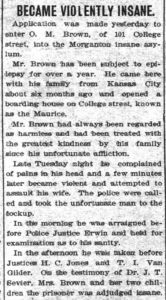
Symptoms Produced a Diagnosis
The field of psychiatry had little science behind it when insane asylums were first established. Many times, alienists (an early name for psychiatrists) had to base their diagnoses on symptoms alone, simply because they did not understand the root causes of a patient’s behavior. Epilepsy presents a good example: Sufferers often had periods of troubling behavior prior to or after a seizure. When doctors looked at these behaviors, they saw insanity rather than a medical condition.
A nutritional deficiency called pellagra also mimicked insanity in some people. This is a disease caused by a niacin (B-vitamin) deficiency, lack of tryptophan (an amino acid) in the diet, or a failure to absorb these nutrients. In the early 1900s many Southern poor ate a diet high in corn, molasses, and fat-back. The corn-heavy diet allowed pellagra to develop because Southern preparation methods did not release corn’s niacin. (In contrast, Mexicans soaked corn in limewater–which released its niacin–before making tortillas, and didn’t develop the condition.)

Pellagra Was Recognized As a Serious Problem
Pellagra’s classic symptoms included dermatitis, diarrhea, and…dementia, which frequently took the form of indifference, stupor and melancholy. Victims were sometimes sent to asylums as a result, where fortunately some actually recovered once their diets became less corn-based.